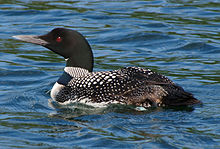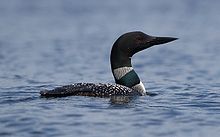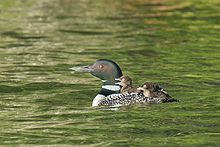- Great Northern Loon
-
Great Northern Loon 
Adult in breeding plumage in Wisconsin, USA Conservation status Scientific classification Kingdom: Animalia Phylum: Chordata Class: Aves Order: Gaviiformes Family: Gaviidae Genus: Gavia Species: G. immer Binomial name Gavia immer
(Brunnich, 1764)Synonyms Gavia imber
The Great Northern Loon, Great Northern Diver, or Common Loon (Gavia immer), is a large member of the loon, or diver, family of birds. The species is known as the Common Loon in North America and the Great Northern Diver in Eurasia; its current name is a compromise proposed by the International Ornithological Committee.[2]
Contents
Taxonomy
The Great Northern Loon is one of the five loon species that make up the genus Gavia, the only genus of the family Gavidae and order Gaviiformes. Its closest relative is the other large black-headed species, the Yellow-billed Loon or White-billed Diver, Gavia adamsii.[3]
The genus name Gavia was the Latin term for the Smew (Mergellus albellus). This small sea-duck is quite unrelated to loons and just happens to be another black-and-white seabird which swims and dives for fish. It is not likely that the Ancient Romans had much knowledge of loons, as these are limited to more northern latitudes and since the end of the last glacial period seem to have occurred only as rare winter migrants in the Mediterranean region.[4][5] The specific name immer is derived from North Germanic names for the bird such as modern Icelandic "Himbrimi".[6] The term is related to Swedish immer and emmer, the grey or blackened ashes of a fire, referring to its dark plumage; or to Latin immergo, to immerse, and immersus, submerged.[7]
The European name "diver" comes from the bird's habit of catching fish by swimming calmly along the surface and then abruptly plunging into the water. The North American name "loon" is a reference to the bird's clumsiness on land, and is derived from Scandinavian words for lame, such as Icelandic "lúinn" and Swedish "lam".[6]
Description
Adults can range from 61–100 cm (24–40 inches) in length with a 122–152 cm (4–5-foot) wingspan, slightly smaller than the similar Yellow-billed Loon (or "White-billed Diver"). The weight can vary from 1.6 to 8 kg (3.6 to 17.6 lbs). On average a Great Northern Loon is about 81 cm (32 inches) long, has a wingspan of 136 cm (54 inches), and weighs about 4.1 kg (9 lbs).
Breeding adults have a black head, white underparts, and a checkered black-and-white mantle. Non-breeding plumage is brownish, with the chin and foreneck white. The bill is black-blue and held horizontally. The bill colour and angle distinguish this species from the similar Yellow-billed Loon.
Distribution and habitat
The Great Northern Loon breeds in Canada, parts of the northern United States, Greenland, and Alaska. There is a smaller population (ca. 3,000 pairs) in Iceland. On isolated occasions they have bred in the far north of Scotland. The female lays 1 to 3 eggs on a hollowed-out mound of dirt and vegetation very close to water. Both parents build the nest, sit on the egg or eggs, and feed the young.
This species winters on sea coasts or on large lakes over a much wider range in Europe and the British Isles as well as in North America.
Behaviour
This species, like all divers, is a specialist fish-eater, catching its prey underwater, diving as deep as 200 feet (60 m). Freshwater diets consist of pike, perch, sunfish, trout, and bass; salt-water diets consist of rock fish, flounder, sea trout, and herring.
The bird needs a long distance to gain momentum for take-off, and is ungainly on landing. Its clumsiness on land is due to the legs being positioned at the rear of the body: this is ideal for diving but not well-suited for walking. When the birds land on water, they skim along on their bellies to slow down, rather than on their feet, as these are set too far back. The loon swims gracefully on the surface, dives as well as any flying bird, and flies competently for hundreds of kilometers in migration. It flies with its neck outstretched, usually calling a particular tremolo that can be used to identify a flying loon. Its call has been alternately called "haunting," "beautiful," "thrilling," "mystical" and "enchanting."[8][9]
Great Northern Loon nests are usually placed on islands, where ground-based predators cannot normally access them. However, eggs and nestlings have been taken by gulls, corvids, raccoons, skunks, minks, foxes, snapping turtles and large fish. Adults are not regularly preyed upon, but have been taken by sea otters (when wintering) and bald eagles.[10] Ospreys have been observed harassing divers, more likely out of kleptoparasitism than predation.[11] When approached by a predator of either its nest or itself, divers sometimes attack the predator by rushing at it and attempting to impale it through the abdomen or the back of the head or neck.
Relationship with humans
 Nest near to water in Maine, United States
Nest near to water in Maine, United States
These birds have disappeared from some lakes in eastern North America due to the effects of acid rain and pollution, as well as lead poisoning from fishing sinkers and mercury contamination from industrial waste. Artificial floating nesting platforms have been provided for loons in some lakes to reduce the impact of changing water levels due to dams and other human activities.
The Great Northern Loon is one of the species to which the Agreement on the Conservation of African-Eurasian Migratory Waterbirds (AEWA) applies.
This diver is well known in Canada, appearing on the "loonie" coin and the previous series of $20 bill, and is the provincial bird of Ontario. Also, it is the state bird of Minnesota.
The voice and appearance of the Great Northern Loon has made it prominent in several Native American tales. These include a story of a loon which created the world in a Chippewa story; a Micmac saga describes Kwee-moo, the loon who was a special messenger of Glooscap (Glu-skap), the tribal hero; native tribes of British Columbia believed that an excess of calls from this bird predicted rain, and even brought it; and the tale of the loon's necklace was handed down in many versions among Pacific Coast peoples. Folk names include big loon, black-billed loon, call-up-a-storm, ember-goose, greenhead, guinea duck, imber diver, ring-necked loon, and walloon.
This bird is central to the plot of the novel Great Northern? by Arthur Ransome (in which it is referred to throughout as Great Northern Diver, with the obsolete scientific name Colymbus immer). The story is set in the Outer Hebrides, where the main characters—a group of children on holiday—notice a pair of loons apparently nesting there. Checking their bird book, they believe this to be the Great Northern Loon; however, this has not previously been seen to nest in northern Scotland, and so they ask for help from an ornithologist. He confirms that these birds are indeed the Great Northern; unfortunately, it soon transpires that he does not wish merely to observe, but wants to steal the eggs and add them to his collection; and to do this, he must first kill the birds. Published in 1947, the story is one where the conservationists are the eventual victors over the egg collector, at a time when the latter "hobby" was not considered to be harmful.[12][13]
References
Notes
- ^ BirdLife International (2008). Gavia immer. In: IUCN 2008. IUCN Red List of Threatened Species. Downloaded on 2008-11-04.
- ^ Gill, F., Wright, M. & Donsker, D. (2009). IOC World Bird Names (version 2.2). Accessed 24 November 2009
- ^ Boertmann, D. (1990). "Phylogeny of the divers, family Gaviidae (Aves)". Steenstrupia 16: 21–36.
- ^ Brodkorb, Pierce (1964) "Catalogue of fossil birds. Part 1 (Archaeopterygiformes through Ardeiformes)" Bulletin of the Florida State Museum, Biological Sciences 7(4): 179–293
- ^ Arnott, W.G. (1964) "Notes on Gavia and Mergvs in Latin Authors." Classical Quarterly (New Series) 14(2): 249-262.
- ^ a b Eriksson, Mats O.G. (2000). "Loons / divers - names -myths – Scandinavian perspective". Wetlands International Diver/Loon Specialist GroupNewsletter (3): 5.
- ^ Paul Johnsgard (1987) Diving Birds of North America. University of Nebraska Press. (Appendix 1)
- ^ "Northwestern Ontario Bird Species - Common Loon". Borealforest.org. http://www.borealforest.org/birds/loon.htm. Retrieved 2011-10-24.
- ^ Feinman, 2010.
- ^ "ADW: Gavia immer: Information". Animaldiversity.ummz.umich.edu. 2004-10-06. http://animaldiversity.ummz.umich.edu/site/accounts/information/Gavia_immer.html. Retrieved 2011-10-24.
- ^ "The Science Behind Algonquin's Animals - Research Projects - Common Loon". Sbaa.ca. http://www.sbaa.ca/projects.asp?cn=303. Retrieved 2011-10-24.
- ^ McGinnis, Molly (February 2004). "Totem Animals in Swallows & Amazons: Great Northern?". All Things Ransome. http://www.allthingsransome.org/literary/totemgreatnorthern.html. Retrieved 26 March 2010.
- ^ Cornett, Michael (16 April 2008). "Great Northern?: A Scottish Adventure of Swallows & Amazons". Amazon.com. http://www.amazon.com/dp/1567922597. Retrieved 26 March 2010.
General references
- Appleby, R. H.; S. C. Madge and Killian Mullarney (1986). "Identification of divers in immature and winter plumages". British Birds 79 (8): 365–391.
External links
- — BTO BirdFacts — Great Northern Diver
- Loons
- Stamps: Common Loon
- Video on ARKive
- Great Northern Diver videos, photos & videos on the Internet Bird Collection
- DigiMorph.org—CT scans of a Great Northern Loon skull
- Common Loon on Animal Diversity Web
- USGS Information — Common Loon
- Cornell Lab of Ornithology — Common Loon Information
- South Dakota Birds — Common Loon Information and Photos
- Flicker Field Guide Birds of the World Photographs
- Watch the National Film Board of Canada animated short Loon Dreaming
Loons or Divers (order: Gaviiformes • family: Gaviidae • genus: Gavia) Species Black-throated Loon (Arctic Loon or Black-throated Diver) • Great Northern Loon (Common Loon or Great Northern Diver) • Pacific Loon (Pacific Diver) • Red-throated Loon (Red-throated Diver) • Yellow-billed Loon (White-billed Diver)Categories:- IUCN Red List least concern species
- Birds of Canada
- Birds of Europe
- Birds of Greenland
- Birds of Italy
- Birds of Turkey
- Birds of Pakistan
- Birds of the United States
- British Isles coastal fauna
- Gaviiformes
- National symbols of Canada
- Provincial symbols of Ontario
- Symbols of Minnesota
- United States state birds
Wikimedia Foundation. 2010.




